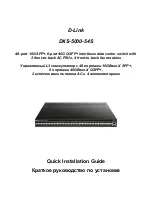
Market Central, Inc.
R1000 NBS/NAC
Page 5 of 16
before sending each and every command to the R1000.
It is possible to switch any or all of the ports to either A or B from serial commands. It is also possible to query the
position of any or all of the ports from serial commands. Serial command functionality is NOT affected by the
position of the front panel key switch. See section 7 for a complete list of commands for the network manageable
models.
RS232 versions only
The following commands are available from the console prompt of the unit. All commands are case insensitive,
although several variable parameters are case sensitive (read/write community names and web password). GET,
SET and PORT can all be abbreviated by the first letter of the command. This allows shorthand entry of switching
commands.
HELP Displays a list of commands. An example output is shown here.
>help
help
R1000 Rev. D
Commands:
get all
get port y (y = port, 1 to 16)
set all X (X = A or B)
set port y X (y = port, 1 to 16, X = A or B)
help or ? (displays this list)
>
get all - shows the status of all ports ex. AAAAAAAA
get port y – shows the status of a specific port ex. port 1 A
set all X – sets all ports to either A or B
set port y x – sets a specific port to either A or B ex. set port 4 A
help or ? shows a list of commands available from the console prompt of the unit
5.3 Ethernet Switching
(SNMP network manageable units only)
In order to use the Ethernet Network port you must set the IPADDRESS and SUBNETMASK and GATEWAY
address of the R1000 before connecting to your network. See section 6 for more details
The R1000 can be switched using SNMP commands over a TCP/IP Ethernet network. See the MIB path summary
in the appendix for a list of SNMP variables and their functions. The R1000 also supports telnet access, and can be
controlled via a telnet session using the same commands as used by the RS232 serial interface. The R1000 also
includes a built in http server that allows all of the commands available via the RS232 serial port to be accessed via
a web browser interface. See section 8 for more details about this feature.
The NETWORK port is 10base-T only. There are two status indicators which function as follows. The LINK led is
on whenever the R1000 network interface is ready for communication. This should happen very shortly after power
on, and should go out if there is some problem with the interface detected by the unit. Note that it does not indicate
that a valid network connection is made. The ACT led will blink whenever the R1000 receives a command from the
network interface. Note that only access to variables on the ‘private’ branch will trigger the ACT led (OID
1.3.6.1.4…). In addition the ACT led will blink when a switching command is issued via the serial port.
After setting up the system and powering up for the first time (see Network Setup section), you may need to change
other parameters for your application. These parameters are stored in non-volatile memory, although they are
immediately active when a change is made they will not become permanent until the SAVE command, followed by
the RESET command are performed.


































